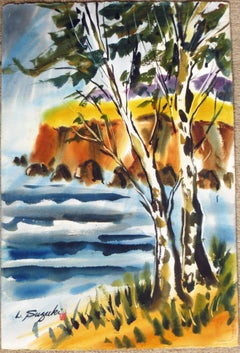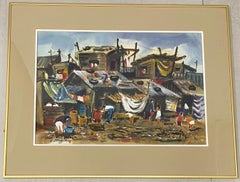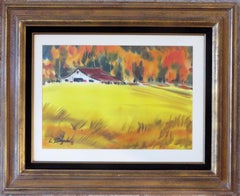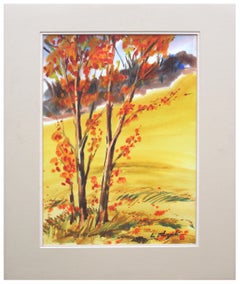Lewis Suzuki Art
Japanese, 1920-2016
Lewis Suzuki was born in Los Angeles, California of Japanese descent. As a boy of nine, Suzuki's father died (1929), and his mother returned to Japan with her six children. There, Suzuki excelled in the art programs in his primary school, attended Kawabata Art Academy in Tokyo, and began exploring the possibility of studying art in the U.S. In 1939, Suzuki moved back to Los Angeles, completed high school and took classes at Otis Art Institute,
In 1941, Suzuki moved to Washington, D.C., where he worked at the Japanese Embassy primarily as a “tea boy” and took classes at Corcoran School of Art. After the bombing of Pearl Harbor, all embassy officials were to return to Japan, but Suzuki wished to remain in the U.S.
He joined the U.S. Army and taught Japanese at the Military Intelligence Service Language School in Minnesota. After the war, he moved to New York, where he studied at the Art Students League and earned a living as a cabinet-maker.
Since the 1950's he resided in Berkeley, California and painted around the Bay Area. There, he specialized in city scenes, rural scenes, seascapes and floral still lifes, done with the wet-into-wet watercolor painting style.
Suzuki once said, “I feel that art has a place in enriching the life of humanity … Through my art, I try to strengthen that part of culture. And I feel that the arts should project the future of human society. To me, it cannot be non-objective or abstract in that sense.” He created a graphic work, “No More Hiroshimas,” and other peace posters for the American Friends Service Committee. Suzuki was a member of the politically active Graphic Arts Workshop from 1953 to 1963.
Suzuki’s bold and imaginative use of color won him numerous awards, including two at the Society of Western Artists show at the De Young Museum in San Francisco. He served on the Berkeley Art Commission and was recognized by the City of Berkeley in 2010. Until recently, he continued to work at his studio on Grant Street in Berkeley, participating in such events as East Bay Open Studios and Berkeley Artisans Holiday Open Studios. His work is well exhibited, listed, and collected.(Biography provided by Robert Azensky Fine Art)
to
1
9
9
7
7
2
Still Life with Flowers
By Lewis Suzuki
Located in San Francisco, CA
Artist: Lewis Suzuki (Japanese/American, 1920/2016)
Title: Still Life with Flowers
Medium: Watercolor
Paper: Watercolor paper
Size: 14.25 x 21.5 inches
Signature: Signed lower...
Category
Mid-20th Century Impressionist Lewis Suzuki Art
Materials
Watercolor
Autumnal Country Barn in Watercolor Landscape on Paper
By Lewis Suzuki
Located in Soquel, CA
Autumnal Country Barn in Watercolor Landscape on Paper
A vibrant rural watercolor scene by Lewis Suzuki (American, 1920-2016). Suzuki is considered an important figure in the waterco...
Category
1970s American Impressionist Lewis Suzuki Art
Materials
Paper, Watercolor
California Coastal Scene
By Lewis Suzuki
Located in San Francisco, CA
Artist: Lewis Suzuki (Japanese/American, 1920/2016)
Untitled: California Coastal Scene
Year: Circa 1970
Medium: Watercolor on ArchesPaper
Image ...
Category
1970s Impressionist Lewis Suzuki Art
Materials
Watercolor
Lewis Suzuki "Squatters in Manila" Original Watercolor C.1960
By Lewis Suzuki
Located in San Francisco, CA
Lewis Suzuki "Squatters in Manila" Original Watercolor C.1960
Original watercolor on paper
Dimensions 21" wide x 14" high
The frame measures 28.25" wide x 22.25" high
Signed in t...
Category
Mid-20th Century Lewis Suzuki Art
Materials
Watercolor
Autumn Landscape with Barn
By Lewis Suzuki
Located in San Francisco, CA
Artist: Lewis Suzuki (Japanese/American, 1920-2016)
Title: Autumn Landscape With Barn
Year: Circa 1970
Medium: Watercolor
Paper: Watercolor pap...
Category
1970s Impressionist Lewis Suzuki Art
Materials
Paper, Watercolor
Aspen in Fall, 1970s Vintage Autumn Landscape Watercolor
By Lewis Suzuki
Located in Soquel, CA
A vibrant 1970's vintage autumn watercolor landscape scene of an aspen tree with fall foliage by Lewis Suzuki (American, 1920-2016). Artist's signatu...
Category
1970s American Impressionist Lewis Suzuki Art
Materials
Watercolor, Rag Paper
Golden Gate Bridge, San Francisco
By Lewis Suzuki
Located in San Francisco, CA
Artist: Lewis Suzuki (Japanese/American, 1920/2016)
Title: Golden Gate Bridge, San Francisco
Year: Circa 1970
Medium: Watercolor
Paper: Watercolor paper
Image size: 14.5 x 10.25 inc...
Category
1970s Impressionist Lewis Suzuki Art
Materials
Watercolor
Landscape with Barn
By Lewis Suzuki
Located in San Francisco, CA
Artist: Lewis Suzuki (Japanese/American, 1920/2016)
Title: Lanscape With Barn
Year: Circa 1970
Medium: Watercolor
Paper: Watercolor paper
Image size: 14.5 x 10.25 inches
paper s...
Category
1970s Impressionist Lewis Suzuki Art
Materials
Watercolor
Landscape with Barn
By Lewis Suzuki
Located in San Francisco, CA
Artist: Lewis Suzuki (Japanese/American, 1920/2016)
Title: Lanscape With Barn
Year: Circa 1970
Medium: Watercolor
Paper: Watercolor paper
Image size: 14.5 x 10.25 inches
paper s...
Category
1970s Impressionist Lewis Suzuki Art
Materials
Watercolor
Related Items
"Monhegan Island, Maine, " Edward Dufner, American Impressionism Landscape View
By Edward Dufner
Located in New York, NY
Edward Dufner (1872 - 1957)
Monhegan Island, Maine
Watercolor on paper
Sight 16 x 20 inches
Signed lower right
With a long-time career as an art teacher and painter of both 'light' and 'dark', Edward Dufner was one of the first students of the Buffalo Fine Arts Academy to earn an Albright Scholarship to study painting in New York. In Buffalo, he had exchanged odd job work for drawing lessons from architect Charles Sumner. He also earned money as an illustrator of a German-language newspaper, and in 1890 took lessons from George Bridgman at the Buffalo Fine Arts Academy.
In 1893, using his scholarship, Dufner moved to Manhattan and enrolled at the Art Students League where he studied with Henry Siddons Mowbray, figure painter and muralist. He also did illustration work for Life, Harper's and Scribner's magazines.
Five years later, in 1898, Dufner went to Paris where he studied at the Academy Julian with Jean-Paul Laurens and privately with James McNeill Whistler. Verification of this relationship, which has been debated by art scholars, comes from researcher Nancy Turk who located at the Smithsonian Institution two 1927 interviews given by Dufner. Turk wrote that Dufner "talks in detail about Whistler, about how he prepared his canvasas and about numerous pieces he painted. . . A great read, the interview puts to bed" the ongoing confusion about whether or not he studied with Whistler.
During his time in France, Dufner summered in the south at Le Pouleu with artists Richard Emil Miller...
Category
Early 20th Century American Impressionist Lewis Suzuki Art
Materials
Paper, Watercolor
"Train Station, " Max Kuehne, Industrial City Scene, American Impressionism
By Max Kuehne
Located in New York, NY
Max Kuehne (1880 - 1968)
Train Station, circa 1910
Watercolor on paper
8 1/4 x 10 1/4 inches
Signed lower right
Provenance:
Private Collection, Illinois
Max Kuehne was born in Halle, Germany on November 7, 1880. During his adolescence the family immigrated to America and settled in Flushing, New York. As a young man, Max was active in rowing events, bicycle racing, swimming and sailing. After experimenting with various occupations, Kuehne decided to study art, which led him to William Merritt Chase's famous school in New York; he was trained by Chase himself, then by Kenneth Hayes Miller. Chase was at the peak of his career, and his portraits were especially in demand. Kuehne would have profited from Chase's invaluable lessons in technique, as well as his inspirational personality. Miller, only four years older than Kuehne, was another of the many artists to benefit from Chase's teachings. Even though Miller still would have been under the spell of Chase upon Kuehne's arrival, he was already experimenting with an aestheticism that went beyond Chase's realism and virtuosity of the brush. Later Miller developed a style dependent upon volumetric figures that recall Italian Renaissance prototypes.
Kuehne moved from Miller to Robert Henri in 1909. Rockwell Kent, who also studied under Chase, Miller, and Henri, expressed what he felt were their respective contributions: "As Chase had taught us to use our eyes, and Henri to enlist our hearts, Miller called on us to use our heads." (Rockwell Kent, It's Me O Lord: The Autobiography of Rockwell Kent. New York: Dodd, Mead and Co., 1955, p. 83). Henri prompted Kuehne to search out the unvarnished realities of urban living; a notable portion of Henri's stylistic formula was incorporated into his work.
Having received such a thorough foundation in art, Kuehne spent a year in Europe's major art museums to study techniques of the old masters. His son Richard named Ernest Lawson as one of Max Kuehne's European traveling companions. In 1911 Kuehne moved to New York where he maintained a studio and painted everyday scenes around him, using the rather Manet-like, dark palette of Henri.
A trip to Gloucester during the following summer engendered a brighter palette. In the words of Gallatin (1924, p. 60), during that summer Kuehne "executed some of his most successful pictures, paintings full of sunlight . . . revealing the fact that he was becoming a colorist of considerable distinction." Kuehne was away in England the year of the Armory Show (1913), where he worked on powerful, painterly seascapes on the rocky shores of Cornwall. Possibly inspired by Henri - who had discovered Madrid in 1900 then took classes there in 1906, 1908 and 1912 - Kuehne visited Spain in 1914; in all, he would spend three years there, maintaining a studio in Granada. He developed his own impressionism and a greater simplicity while in Spain, under the influence of the brilliant Mediterranean light. George Bellows convinced Kuehne to spend the summer of 1919 in Rockport, Maine (near Camden). The influence of Bellows was more than casual; he would have intensified Kuehne's commitment to paint life "in the raw" around him.
After another brief trip to Spain in 1920, Kuehne went to the other Rockport (Cape Ann, Massachusetts) where he was accepted as a member of the vigorous art colony, spearheaded by Aldro T. Hibbard. Rockport's picturesque ambiance fulfilled the needs of an artist-sailor: as a writer in the Gloucester Daily Times explained, "Max Kuehne came to Rockport to paint, but he stayed to sail." The 1920s was a boom decade for Cape Ann, as it was for the rest of the nation. Kuehne's studio in Rockport was formerly occupied by Jonas Lie.
Kuehne spent the summer of 1923 in Paris, where in July, André Breton started a brawl as the curtain went up on a play by his rival Tristan Tzara; the event signified the demise of the Dada movement. Kuehne could not relate to this avant-garde art but was apparently influenced by more traditional painters — the Fauves, Nabis, and painters such as Bonnard. Gallatin perceived a looser handling and more brilliant color in the pictures Kuehne brought back to the States in the fall. In 1926, Kuehne won the First Honorable Mention at the Carnegie Institute, and he re-exhibited there, for example, in 1937 (Before the Wind). Besides painting, Kuehne did sculpture, decorative screens, and furniture work with carved and gilded molding. In addition, he designed and carved his own frames, and John Taylor Adams encouraged Kuehne to execute etchings. Through his talents in all these media he was able to survive the Depression, and during the 1940s and 1950s these activities almost eclipsed his easel painting. In later years, Kuehne's landscapes and still-lifes show the influence of Cézanne and Bonnard, and his style changed radically.
Max Kuehne died in 1968. He exhibited his work at the National Academy of Design, the Art Institute of Chicago, the Carnegie Institute in Pittsburgh, the Memorial Art Gallery of the University of Rochester, and in various New York City galleries. Kuehne's works are in the following public collections: the Detroit Institute of Arts (Marine Headland), the Whitney Museum (Diamond Hill...
Category
1910s American Impressionist Lewis Suzuki Art
Materials
Paper, Watercolor
A Canal in Venice, Hanging Out The Washing......
Located in Cotignac, FR
A watercolour on paper view of a canal in Venice by French artist Paule Soulé. The pain ting is signed bottom right and presented in a gilt and painted wood frame under glass.
A cha...
Category
Early 20th Century Impressionist Lewis Suzuki Art
Materials
Watercolor, Pencil, Paper
Pavilion with waterfall, an ink wash attributed to Hubert Robert (1733 - 1808)
By Hubert Robert
Located in PARIS, FR
This large wash drawing is a slightly enlarged version of a composition executed by Hubert Robert in 1761, at the end of his stay in Rome. This composition is a marvellous synthesis of the painter's art: the clatter of the waterfall, in a grandiose setting inspired by antiquity, is opposed to the intimacy of a genre scene, made up of a few peasant women performing some agricultural work.
1. The stay in Italy, an important founding stage in Hubert Robert's carrier
Hubert Robert came from a privileged family of Lorraine origin, linked to the Choiseul-Stainville family, where his father was an intendant. The protection of this powerful aristocratic family enabled him to study classical art at the Collège de Navarre (between 1745 and 1751). After a first apprenticeship in the workshop of the sculptor Slodtz (1705 - 1764), he was invited by Etienne-François de Choiseul-Beaupré-Stainville (the future Duke of Choiseul, then Count of Stainville) to join him in Rome when the latter had just been appointed ambassador.
Hubert Robert arrived in Rome on 4 November 1754, aged twenty-one, and remained there until 24 July 1765. Thanks to his patron, he obtained a place as a pensioneer at the Académie de France without having won the prestigious Prix de Rome. On his arrival in Rome, he frequented the studio of the painter Giovanni Paolo Panini (1691 - 1765), the inventor of the ruins painting, and also benefited from the proximity of Giovanni Battista Piranesi’s studio (1720 - 1778). During his eleven-year stay in Rome, Hubert Robert studied the great Italian masters and drew many of the great archaeological sites, multiplying the sketches which he would use throughout his career, becoming one of the masters of the "ruin landscape".
Back in Paris in 1765, he was very successful. He was accepted and admitted to the Royal Academy of Painting and Sculpture on the same day, July 26th 1766, which was very unusual. He was appointed draughtsman of the king's gardens in 1784, then guard of the Royal Museum from 1784 to 1792. Arrested in 1793 and detained in the prisons of Sainte Pélagie and Saint-Lazare, he was released in 1794 after the fall of Robespierre and undertook a second trip to Italy. In 1800, Hubert Robert was appointed curator of the new Central Museum and died at his home in Paris in 1808.
2. Description of the artwork
This composition, formerly called "La Cascade du Belvédère Pamphile" , is undoubtedly inspired by the water theatres of the Frascati villas. Hubert Robert presents a hemicycle of columns with rustic bossages at the foot of which is a cascade of water falls into a basin. The hemicycle is flanked by two high walls, pierced by window wells topped with antique masks...
Category
1760s Old Masters Lewis Suzuki Art
Materials
Ink, Watercolor
The Jurassic Coast, Dorset.
By Ruskin Spear
Located in Cotignac, FR
An English watercolour on paper coastal scene signed with initials 'RS' bottom right. Presented in its original gilt wood frame under glass with trade label to the backboard from Deighton’s Strand Gallery. This gallery was well-known during the 1930s as fine art dealers and frame makers – it was located off Trafalgar square.
Though he often signed with his full name Ruskin Spear's work on paper 'Hammersmith Grove' is signed in the same initials as our work and hence the attribution. This work is also stylistically similar to his other drawings of seascapes and coastal landscapes.
This is a charming and fresh view of a coastal landscape probably the Jurassic coast of Dorset or his beloved Cornwall. The vertiginous composition gives it an angular almost abstract form highlighted by the contrast between the colour of the rockface, the vegetation and the blue sea. The work is in nice condition and wonderful to have the original framing.
Initially influenced by Walter Sickert, the Camden Town Group...
Category
Early 20th Century Impressionist Lewis Suzuki Art
Materials
Watercolor, Paper
Bridge to Brooklyn #382
Located in Salt Lake City, UT
Bridge to Brooklyn #382, watercolor, 10.5 x 14 inches (Framed size: 18 x 21 inches), $1,750
Waldo Midgley (1888-1986) had a fruitful career spanning eig...
Category
1970s Ashcan School Lewis Suzuki Art
Materials
Watercolor
Still Life with Flowers by Isidor Rosenstock
By Isidore Rosenstock
Located in Pasadena, CA
ISIDOR Rosenstock, born in Strasbourg in 1880, died in 1956. 20th century
painter of landscapes and flowers, watercolor.
He exhibited in Paris at the Salon of French Artists, the...
Category
Late 19th Century Impressionist Lewis Suzuki Art
Materials
Gouache
Homestead, Regional American Landscape by Pennsylvania Impressionist
By Harry Leith-Ross
Located in Doylestown, PA
"Homestead" is a regional, American landscape by Pennsylvania Impressionist and New Hope School painter Harry Leith-Ross. The painting is a 14" x 19" watercolor on paper, signed "Lei...
Category
1940s American Impressionist Lewis Suzuki Art
Materials
Watercolor, Archival Paper
H 23.5 in W 29 in D 1.5 in
'Amalfi, Italy', mixed media on paper c2005
Located in Frome, Somerset
'Amalfi, Italy'. Mixed media on paper . circa 2005.
painting 41cm x 54cm
glazed frame 62cmx 82cm
Atmospheric view of the seafront topography and buildings of the famous coastal town...
Category
Early 2000s Modern Lewis Suzuki Art
Materials
Watercolor
Les Baux de Provence.
Located in Cotignac, FR
Late 20th century gouache landscape of "Les Baux de Provence" on paper by French artist Désiré Villain, signed bottom left and to the reverse and dated 199...
Category
Late 20th Century Impressionist Lewis Suzuki Art
Materials
Paper, Gouache, Board
Flowers Paper, watercolor, 1994, 40x30 cm
By Oskars Berzins
Located in Riga, LV
"Flowers" is a watercolor artwork created on paper in 1994, with dimensions of 40x30 cm. The painting showcases a vibrant and colorful depiction of various flowers, capturing the beauty and delicacy of these natural elements.
Oskars Berzins (1940)
Born on September 20, 1940
Education
1970 graduated from Art academy of Latvia Graphics department.
Diploma work-holiday poster...
Category
1990s Impressionist Lewis Suzuki Art
Materials
Paper, Watercolor
'Moss Beach, Monterey, California', Pacific Coastal Landscape, ASL NYC, Benezit
By Elmer Wachtel
Located in Santa Cruz, CA
An early-20th-century, landscape showing a view of the coastline at Moss Beach in Monterey County with slate-blue skies overhead and a view towards a stand ...
Category
Early 1900s American Impressionist Lewis Suzuki Art
Materials
Gouache, Watercolor, Paper
Lewis Suzuki art for sale on 1stDibs.
Find a wide variety of authentic Lewis Suzuki art available for sale on 1stDibs. You can also browse by medium to find art by Lewis Suzuki in paint, watercolor, paper and more. Much of the original work by this artist or collective was created during the 20th century and is mostly associated with the Impressionist style. Not every interior allows for large Lewis Suzuki art, so small editions measuring 15 inches across are available. Customers who are interested in this artist might also find the work of Jake Lee, Diane Baldwin, and Cheryl Trotter. Lewis Suzuki art prices can differ depending upon medium, time period and other attributes. On 1stDibs, the price for these items starts at $650 and tops out at $1,200, while the average work can sell for $950.






